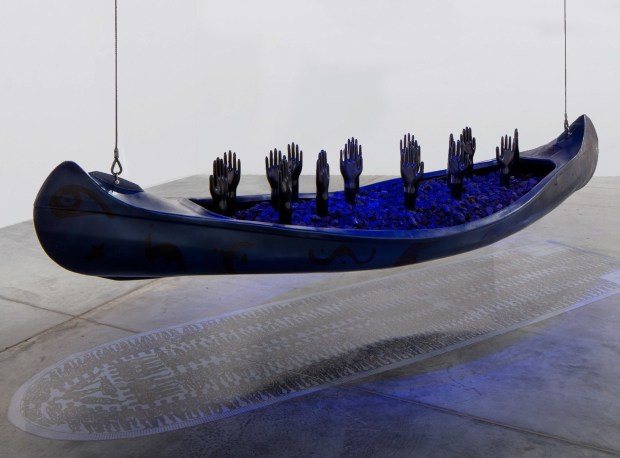

By Stephanie Seidel
For millennia, people have gazed at the stars to conjure myths that make sense of the world around them – evidenced in objects that span from the Nebra sky disc (c.1800–1600 BCE) to modern-day astrological charts.
Celestial bodies, constellations and zodiac signs feature prominently in the work of American artist Betye Saar, whose iconic box assemblages, such as Black Girl’s Window (1969) and The Liberation of Aunt Jemima (1972), have come to define her practice within the canon of US West Coast assemblage and Black feminist art. It is lesser-known that, from the late 1970s, Saar expanded these intimately scaled artworks into what art historian Lowery Stokes Sims called ‘walk-in boxes’: immersive, room-size installations that combine found objects with natural materials and works on paper. Through ritual acts, Saar assembles syncretic spaces that incorporate spiritual, autobiographical and politically charged elements foraged from flea markets and the annals of history. While these installations bear close formal and thematic similarities to the assemblages, there is a crucial difference: they are not fixed ensembles minutely re-created across exhibitions but dynamic, temporary configurations of objects, which cycle through iterations as their connotations shift within the different atmospheres they create.
One such work is Celestial Universe (1988), which has been part of a number of installations over the decades. Hand-painted on silk taffeta, this large, dark blue banner displays a star map from 1840 complete with zodiac signs and figures of the constellations originating from Greco-Roman mythology. Suspended from the ceiling to hover like a canopy above a candle-lined canoe, the work premiered in ‘Voyages: Dreams and Destinations’ at the National Taiwan Museum of Art in Taichung in 1988, evoking the use of constellations for nautical navigation. A few years later, the work served as a backdrop for the installation Of Matter and Spirit (1992). Hung across two walls, it was accompanied by an art deco card table surrounded by four chairs. In this séance-like scene, Saar combined Celestial Universe with ancient runes, symbols of astrology and Vodou, tarot cards and an animal skull – all denoting spiritual practices across cultures that seek to reveal what lies beyond the rationally knowable. Most recently, the banner featured alongside Gliding into Midnight (2019): a dark blue canoe suspended from the ceiling, filled with black mannequin hands reaching out of glistening coal, illuminated by a deep blue light and hung above a diagram of the slave ship Brooks. Here referencing the horror and inhumanity of the Middle Passage, the night sky of Celestial Universe may symbolize a space of liberatory potential that reaches beyond the limited map of the past and present, inscribed as it still is with deep lines of colonization and subjugation.
Celestial Universe moves through these installations akin to a theatrical prop. As Saar re-configures the works again and again, the histories of each object amplify the layered narratives that unfold between the ensembles. Each installation embodies a syncretic polyvocality that enables every viewer to find their own entryway and throughlines: a set of meanings that are dependent on each observer’s position, both spatially and personally, as they become part of these shifting constellations.